PUBH6006: Community Engagement and Ebola Virus Emergency Plan
VerifiedAdded on 2022/11/26
|9
|2480
|320
Report
AI Summary
This report provides a comprehensive analysis of an Ebola Virus Disease (EVD) emergency plan, emphasizing the crucial role of community engagement in preventing and controlling outbreaks. The report outlines various steps in an emergency response plan, including multi-sectoral coordination, surveillance with community participation, risk communication, promotion of preventive actions, community engagement, public information, monitoring and evaluation, and social mobilization. It highlights the importance of a coordinated approach involving government agencies, healthcare organizations, and community members to effectively address the spread of the virus. The report stresses the need for clear communication strategies, capacity building, and the empowerment of communities to take an active role in the response. It underscores the significance of monitoring and evaluation to assess the effectiveness of interventions and adapt strategies as needed. The conclusion emphasizes the necessity of community involvement, education, and hygiene promotion in minimizing the impact of EVD, while also acknowledging the ongoing global efforts to develop pre-vaccines.
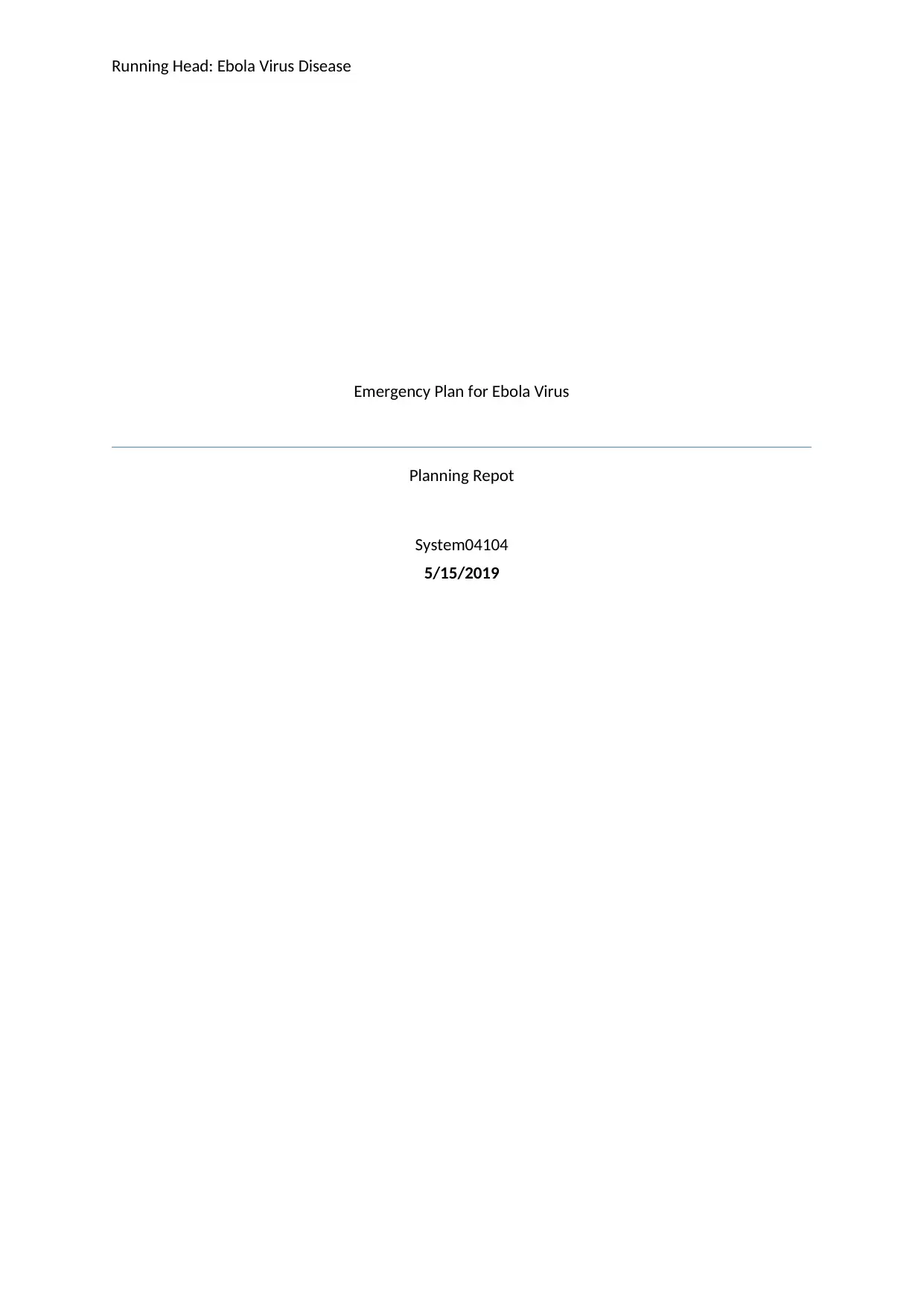
Running Head: Ebola Virus Disease
Emergency Plan for Ebola Virus
Planning Repot
System04104
5/15/2019
Emergency Plan for Ebola Virus
Planning Repot
System04104
5/15/2019
Paraphrase This Document
Need a fresh take? Get an instant paraphrase of this document with our AI Paraphraser
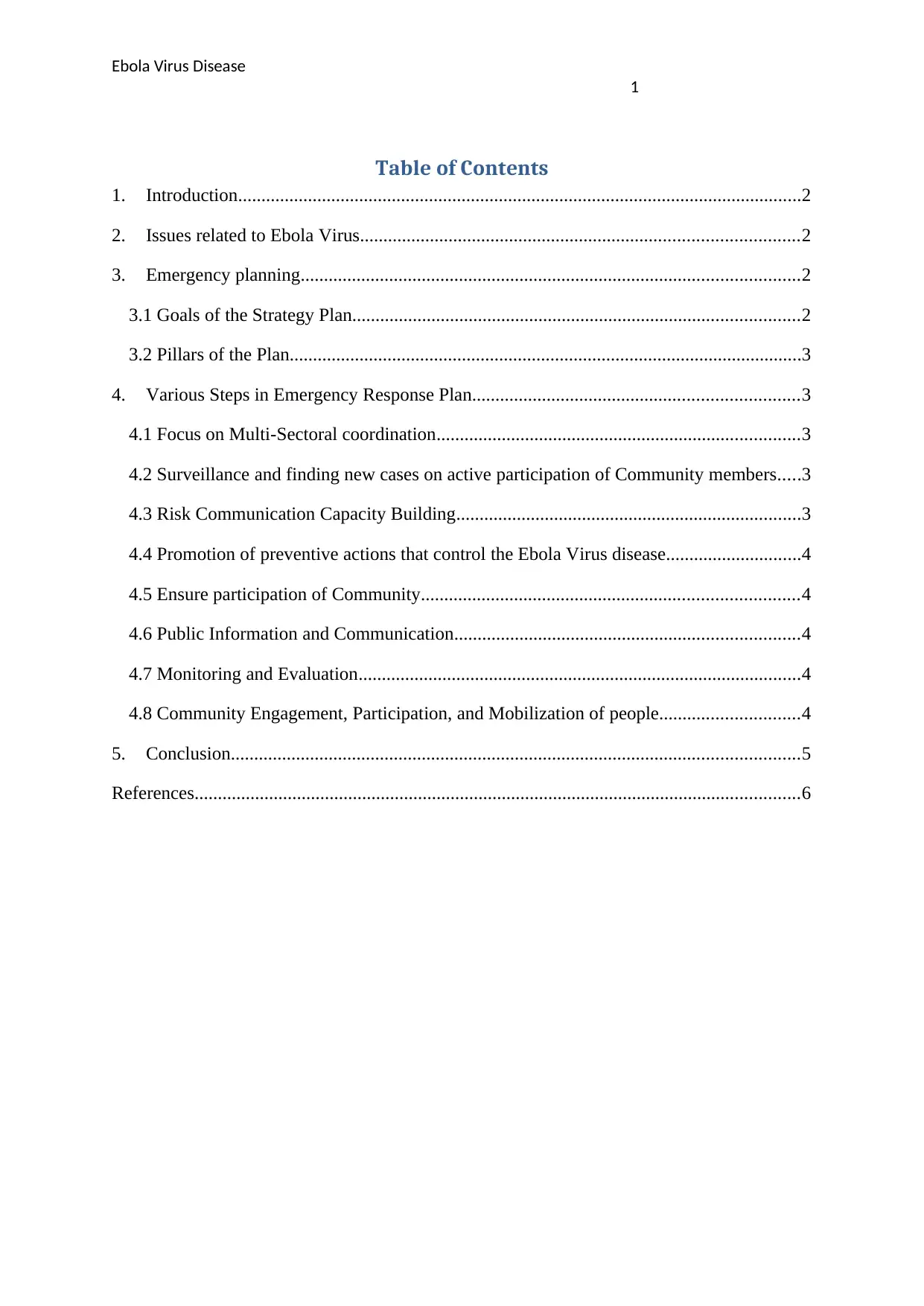
Ebola Virus Disease
1
Table of Contents
1. Introduction.........................................................................................................................2
2. Issues related to Ebola Virus..............................................................................................2
3. Emergency planning...........................................................................................................2
3.1 Goals of the Strategy Plan................................................................................................2
3.2 Pillars of the Plan..............................................................................................................3
4. Various Steps in Emergency Response Plan......................................................................3
4.1 Focus on Multi-Sectoral coordination..............................................................................3
4.2 Surveillance and finding new cases on active participation of Community members.....3
4.3 Risk Communication Capacity Building..........................................................................3
4.4 Promotion of preventive actions that control the Ebola Virus disease.............................4
4.5 Ensure participation of Community.................................................................................4
4.6 Public Information and Communication..........................................................................4
4.7 Monitoring and Evaluation...............................................................................................4
4.8 Community Engagement, Participation, and Mobilization of people..............................4
5. Conclusion..........................................................................................................................5
References..................................................................................................................................6
1
Table of Contents
1. Introduction.........................................................................................................................2
2. Issues related to Ebola Virus..............................................................................................2
3. Emergency planning...........................................................................................................2
3.1 Goals of the Strategy Plan................................................................................................2
3.2 Pillars of the Plan..............................................................................................................3
4. Various Steps in Emergency Response Plan......................................................................3
4.1 Focus on Multi-Sectoral coordination..............................................................................3
4.2 Surveillance and finding new cases on active participation of Community members.....3
4.3 Risk Communication Capacity Building..........................................................................3
4.4 Promotion of preventive actions that control the Ebola Virus disease.............................4
4.5 Ensure participation of Community.................................................................................4
4.6 Public Information and Communication..........................................................................4
4.7 Monitoring and Evaluation...............................................................................................4
4.8 Community Engagement, Participation, and Mobilization of people..............................4
5. Conclusion..........................................................................................................................5
References..................................................................................................................................6
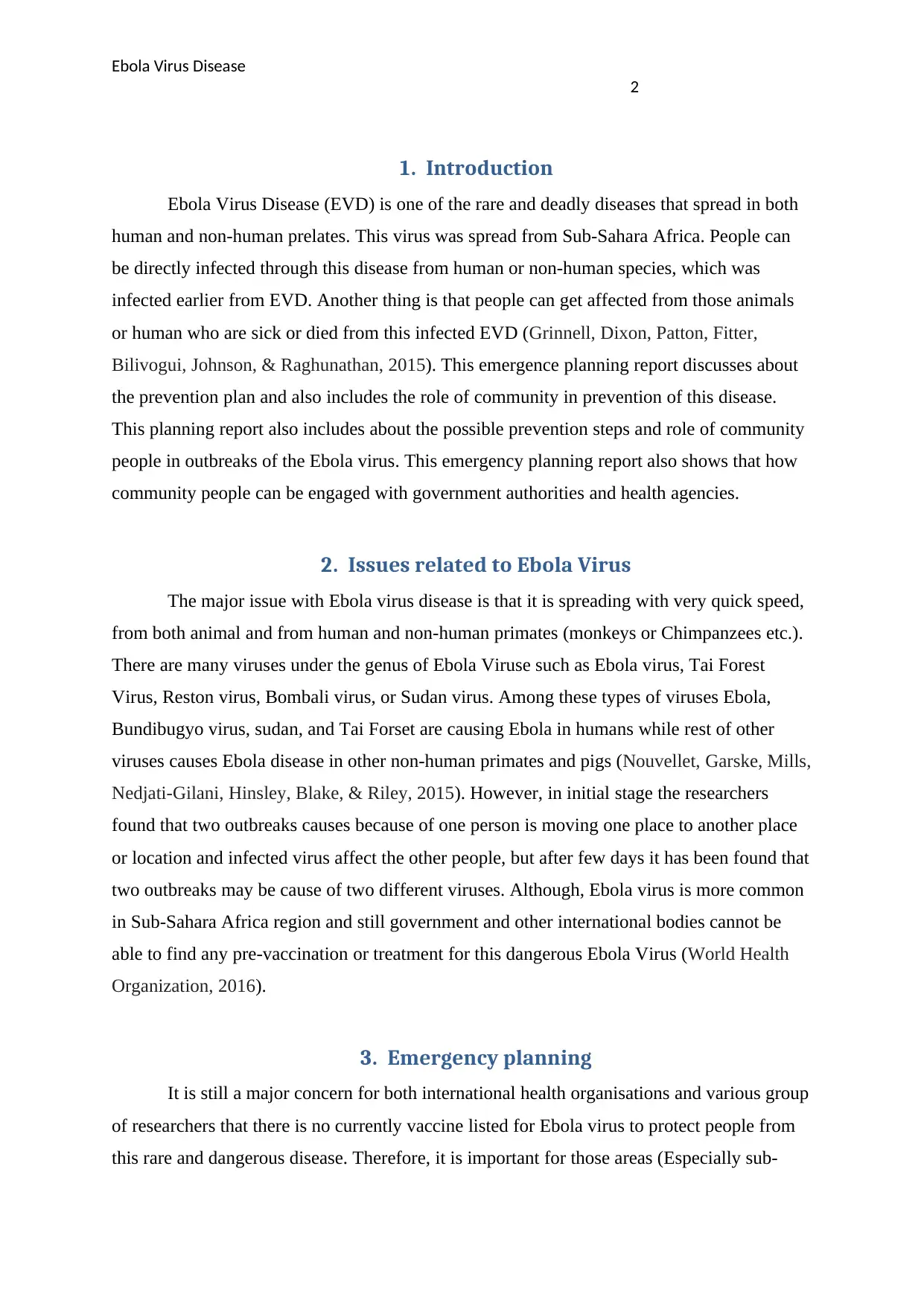
Ebola Virus Disease
2
1. Introduction
Ebola Virus Disease (EVD) is one of the rare and deadly diseases that spread in both
human and non-human prelates. This virus was spread from Sub-Sahara Africa. People can
be directly infected through this disease from human or non-human species, which was
infected earlier from EVD. Another thing is that people can get affected from those animals
or human who are sick or died from this infected EVD (Grinnell, Dixon, Patton, Fitter,
Bilivogui, Johnson, & Raghunathan, 2015). This emergence planning report discusses about
the prevention plan and also includes the role of community in prevention of this disease.
This planning report also includes about the possible prevention steps and role of community
people in outbreaks of the Ebola virus. This emergency planning report also shows that how
community people can be engaged with government authorities and health agencies.
2. Issues related to Ebola Virus
The major issue with Ebola virus disease is that it is spreading with very quick speed,
from both animal and from human and non-human primates (monkeys or Chimpanzees etc.).
There are many viruses under the genus of Ebola Viruse such as Ebola virus, Tai Forest
Virus, Reston virus, Bombali virus, or Sudan virus. Among these types of viruses Ebola,
Bundibugyo virus, sudan, and Tai Forset are causing Ebola in humans while rest of other
viruses causes Ebola disease in other non-human primates and pigs (Nouvellet, Garske, Mills,
Nedjati-Gilani, Hinsley, Blake, & Riley, 2015). However, in initial stage the researchers
found that two outbreaks causes because of one person is moving one place to another place
or location and infected virus affect the other people, but after few days it has been found that
two outbreaks may be cause of two different viruses. Although, Ebola virus is more common
in Sub-Sahara Africa region and still government and other international bodies cannot be
able to find any pre-vaccination or treatment for this dangerous Ebola Virus (World Health
Organization, 2016).
3. Emergency planning
It is still a major concern for both international health organisations and various group
of researchers that there is no currently vaccine listed for Ebola virus to protect people from
this rare and dangerous disease. Therefore, it is important for those areas (Especially sub-
2
1. Introduction
Ebola Virus Disease (EVD) is one of the rare and deadly diseases that spread in both
human and non-human prelates. This virus was spread from Sub-Sahara Africa. People can
be directly infected through this disease from human or non-human species, which was
infected earlier from EVD. Another thing is that people can get affected from those animals
or human who are sick or died from this infected EVD (Grinnell, Dixon, Patton, Fitter,
Bilivogui, Johnson, & Raghunathan, 2015). This emergence planning report discusses about
the prevention plan and also includes the role of community in prevention of this disease.
This planning report also includes about the possible prevention steps and role of community
people in outbreaks of the Ebola virus. This emergency planning report also shows that how
community people can be engaged with government authorities and health agencies.
2. Issues related to Ebola Virus
The major issue with Ebola virus disease is that it is spreading with very quick speed,
from both animal and from human and non-human primates (monkeys or Chimpanzees etc.).
There are many viruses under the genus of Ebola Viruse such as Ebola virus, Tai Forest
Virus, Reston virus, Bombali virus, or Sudan virus. Among these types of viruses Ebola,
Bundibugyo virus, sudan, and Tai Forset are causing Ebola in humans while rest of other
viruses causes Ebola disease in other non-human primates and pigs (Nouvellet, Garske, Mills,
Nedjati-Gilani, Hinsley, Blake, & Riley, 2015). However, in initial stage the researchers
found that two outbreaks causes because of one person is moving one place to another place
or location and infected virus affect the other people, but after few days it has been found that
two outbreaks may be cause of two different viruses. Although, Ebola virus is more common
in Sub-Sahara Africa region and still government and other international bodies cannot be
able to find any pre-vaccination or treatment for this dangerous Ebola Virus (World Health
Organization, 2016).
3. Emergency planning
It is still a major concern for both international health organisations and various group
of researchers that there is no currently vaccine listed for Ebola virus to protect people from
this rare and dangerous disease. Therefore, it is important for those areas (Especially sub-
⊘ This is a preview!⊘
Do you want full access?
Subscribe today to unlock all pages.

Trusted by 1+ million students worldwide
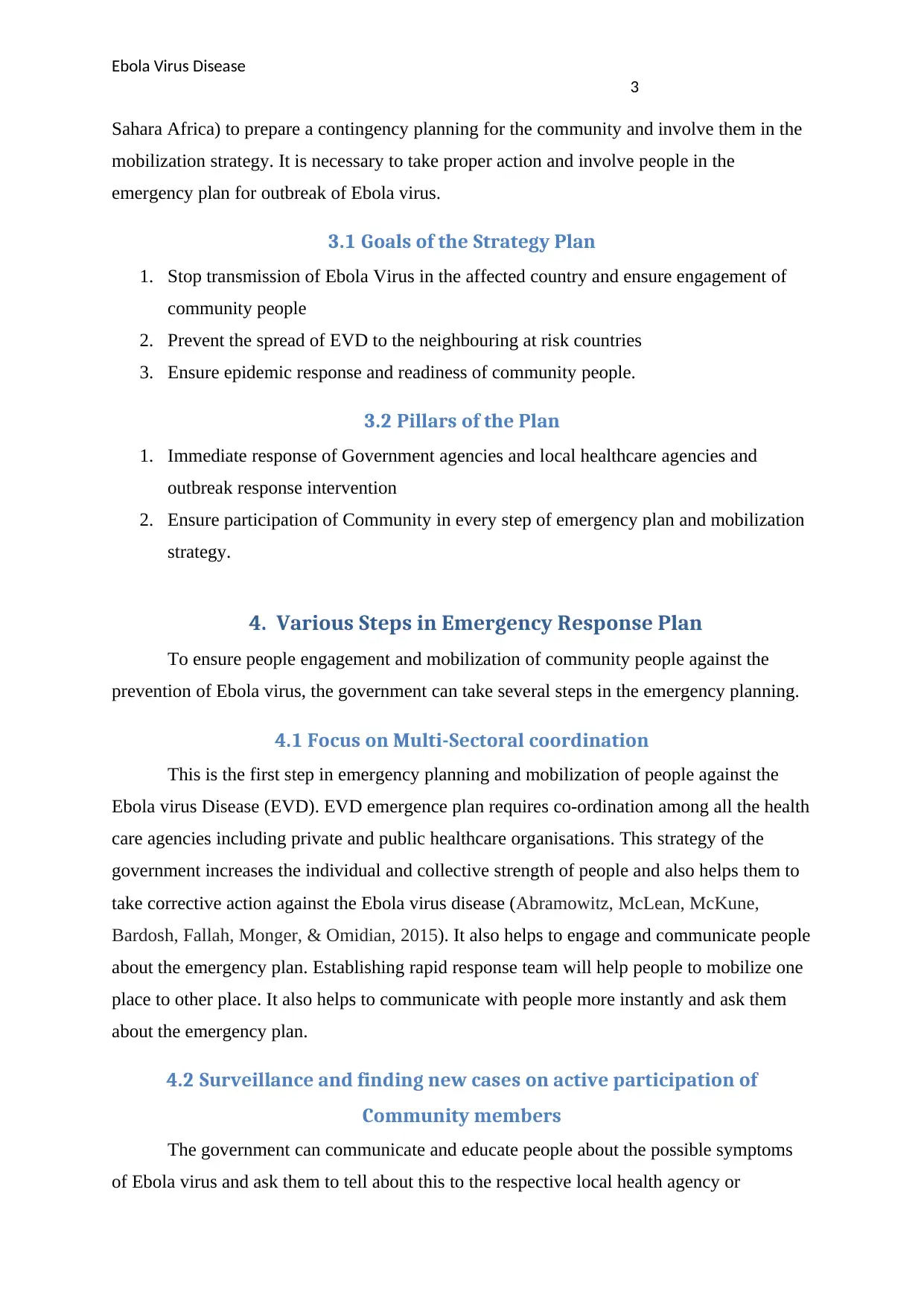
Ebola Virus Disease
3
Sahara Africa) to prepare a contingency planning for the community and involve them in the
mobilization strategy. It is necessary to take proper action and involve people in the
emergency plan for outbreak of Ebola virus.
3.1 Goals of the Strategy Plan
1. Stop transmission of Ebola Virus in the affected country and ensure engagement of
community people
2. Prevent the spread of EVD to the neighbouring at risk countries
3. Ensure epidemic response and readiness of community people.
3.2 Pillars of the Plan
1. Immediate response of Government agencies and local healthcare agencies and
outbreak response intervention
2. Ensure participation of Community in every step of emergency plan and mobilization
strategy.
4. Various Steps in Emergency Response Plan
To ensure people engagement and mobilization of community people against the
prevention of Ebola virus, the government can take several steps in the emergency planning.
4.1 Focus on Multi-Sectoral coordination
This is the first step in emergency planning and mobilization of people against the
Ebola virus Disease (EVD). EVD emergence plan requires co-ordination among all the health
care agencies including private and public healthcare organisations. This strategy of the
government increases the individual and collective strength of people and also helps them to
take corrective action against the Ebola virus disease (Abramowitz, McLean, McKune,
Bardosh, Fallah, Monger, & Omidian, 2015). It also helps to engage and communicate people
about the emergency plan. Establishing rapid response team will help people to mobilize one
place to other place. It also helps to communicate with people more instantly and ask them
about the emergency plan.
4.2 Surveillance and finding new cases on active participation of
Community members
The government can communicate and educate people about the possible symptoms
of Ebola virus and ask them to tell about this to the respective local health agency or
3
Sahara Africa) to prepare a contingency planning for the community and involve them in the
mobilization strategy. It is necessary to take proper action and involve people in the
emergency plan for outbreak of Ebola virus.
3.1 Goals of the Strategy Plan
1. Stop transmission of Ebola Virus in the affected country and ensure engagement of
community people
2. Prevent the spread of EVD to the neighbouring at risk countries
3. Ensure epidemic response and readiness of community people.
3.2 Pillars of the Plan
1. Immediate response of Government agencies and local healthcare agencies and
outbreak response intervention
2. Ensure participation of Community in every step of emergency plan and mobilization
strategy.
4. Various Steps in Emergency Response Plan
To ensure people engagement and mobilization of community people against the
prevention of Ebola virus, the government can take several steps in the emergency planning.
4.1 Focus on Multi-Sectoral coordination
This is the first step in emergency planning and mobilization of people against the
Ebola virus Disease (EVD). EVD emergence plan requires co-ordination among all the health
care agencies including private and public healthcare organisations. This strategy of the
government increases the individual and collective strength of people and also helps them to
take corrective action against the Ebola virus disease (Abramowitz, McLean, McKune,
Bardosh, Fallah, Monger, & Omidian, 2015). It also helps to engage and communicate people
about the emergency plan. Establishing rapid response team will help people to mobilize one
place to other place. It also helps to communicate with people more instantly and ask them
about the emergency plan.
4.2 Surveillance and finding new cases on active participation of
Community members
The government can communicate and educate people about the possible symptoms
of Ebola virus and ask them to tell about this to the respective local health agency or
Paraphrase This Document
Need a fresh take? Get an instant paraphrase of this document with our AI Paraphraser
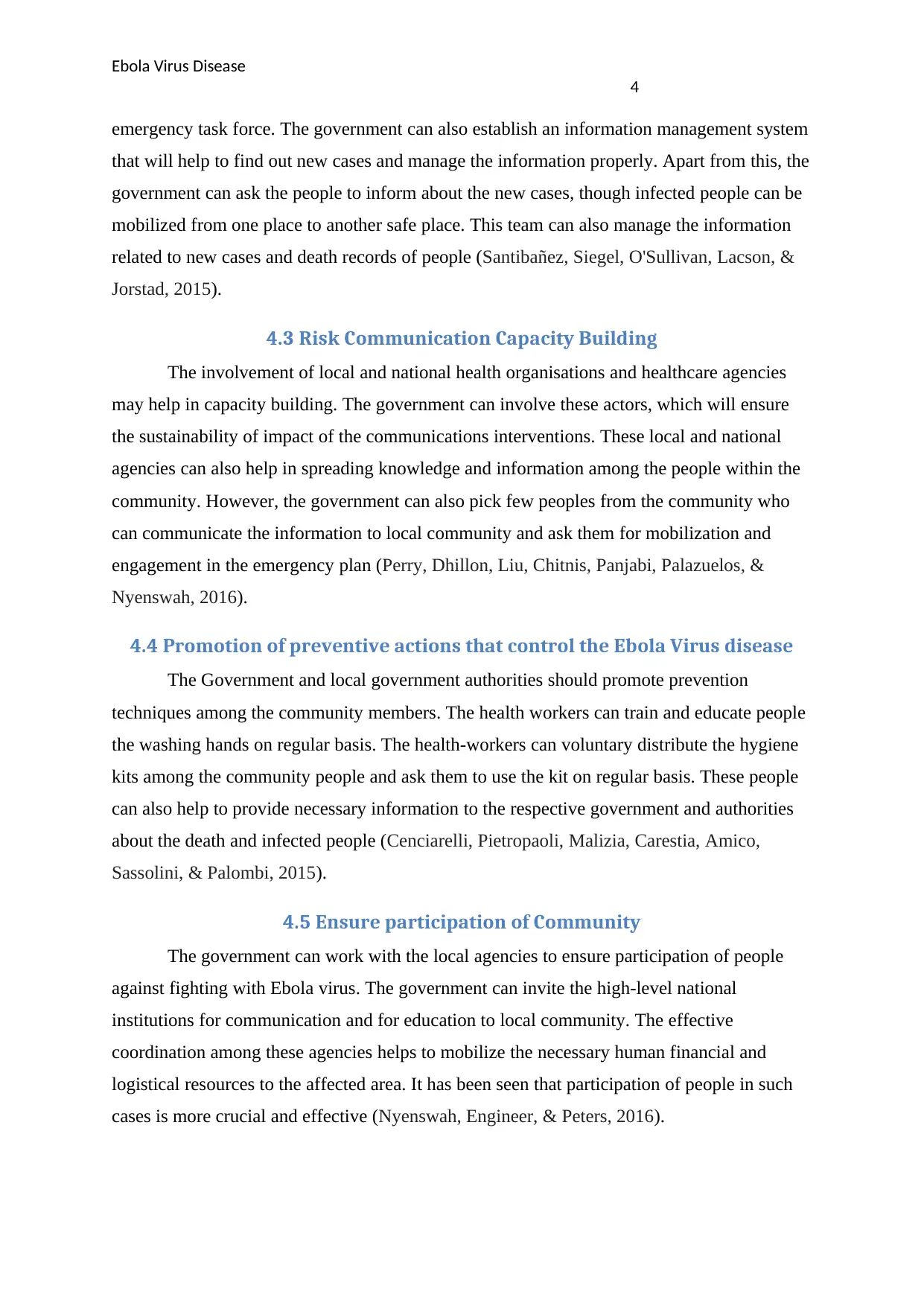
Ebola Virus Disease
4
emergency task force. The government can also establish an information management system
that will help to find out new cases and manage the information properly. Apart from this, the
government can ask the people to inform about the new cases, though infected people can be
mobilized from one place to another safe place. This team can also manage the information
related to new cases and death records of people (Santibañez, Siegel, O'Sullivan, Lacson, &
Jorstad, 2015).
4.3 Risk Communication Capacity Building
The involvement of local and national health organisations and healthcare agencies
may help in capacity building. The government can involve these actors, which will ensure
the sustainability of impact of the communications interventions. These local and national
agencies can also help in spreading knowledge and information among the people within the
community. However, the government can also pick few peoples from the community who
can communicate the information to local community and ask them for mobilization and
engagement in the emergency plan (Perry, Dhillon, Liu, Chitnis, Panjabi, Palazuelos, &
Nyenswah, 2016).
4.4 Promotion of preventive actions that control the Ebola Virus disease
The Government and local government authorities should promote prevention
techniques among the community members. The health workers can train and educate people
the washing hands on regular basis. The health-workers can voluntary distribute the hygiene
kits among the community people and ask them to use the kit on regular basis. These people
can also help to provide necessary information to the respective government and authorities
about the death and infected people (Cenciarelli, Pietropaoli, Malizia, Carestia, Amico,
Sassolini, & Palombi, 2015).
4.5 Ensure participation of Community
The government can work with the local agencies to ensure participation of people
against fighting with Ebola virus. The government can invite the high-level national
institutions for communication and for education to local community. The effective
coordination among these agencies helps to mobilize the necessary human financial and
logistical resources to the affected area. It has been seen that participation of people in such
cases is more crucial and effective (Nyenswah, Engineer, & Peters, 2016).
4
emergency task force. The government can also establish an information management system
that will help to find out new cases and manage the information properly. Apart from this, the
government can ask the people to inform about the new cases, though infected people can be
mobilized from one place to another safe place. This team can also manage the information
related to new cases and death records of people (Santibañez, Siegel, O'Sullivan, Lacson, &
Jorstad, 2015).
4.3 Risk Communication Capacity Building
The involvement of local and national health organisations and healthcare agencies
may help in capacity building. The government can involve these actors, which will ensure
the sustainability of impact of the communications interventions. These local and national
agencies can also help in spreading knowledge and information among the people within the
community. However, the government can also pick few peoples from the community who
can communicate the information to local community and ask them for mobilization and
engagement in the emergency plan (Perry, Dhillon, Liu, Chitnis, Panjabi, Palazuelos, &
Nyenswah, 2016).
4.4 Promotion of preventive actions that control the Ebola Virus disease
The Government and local government authorities should promote prevention
techniques among the community members. The health workers can train and educate people
the washing hands on regular basis. The health-workers can voluntary distribute the hygiene
kits among the community people and ask them to use the kit on regular basis. These people
can also help to provide necessary information to the respective government and authorities
about the death and infected people (Cenciarelli, Pietropaoli, Malizia, Carestia, Amico,
Sassolini, & Palombi, 2015).
4.5 Ensure participation of Community
The government can work with the local agencies to ensure participation of people
against fighting with Ebola virus. The government can invite the high-level national
institutions for communication and for education to local community. The effective
coordination among these agencies helps to mobilize the necessary human financial and
logistical resources to the affected area. It has been seen that participation of people in such
cases is more crucial and effective (Nyenswah, Engineer, & Peters, 2016).
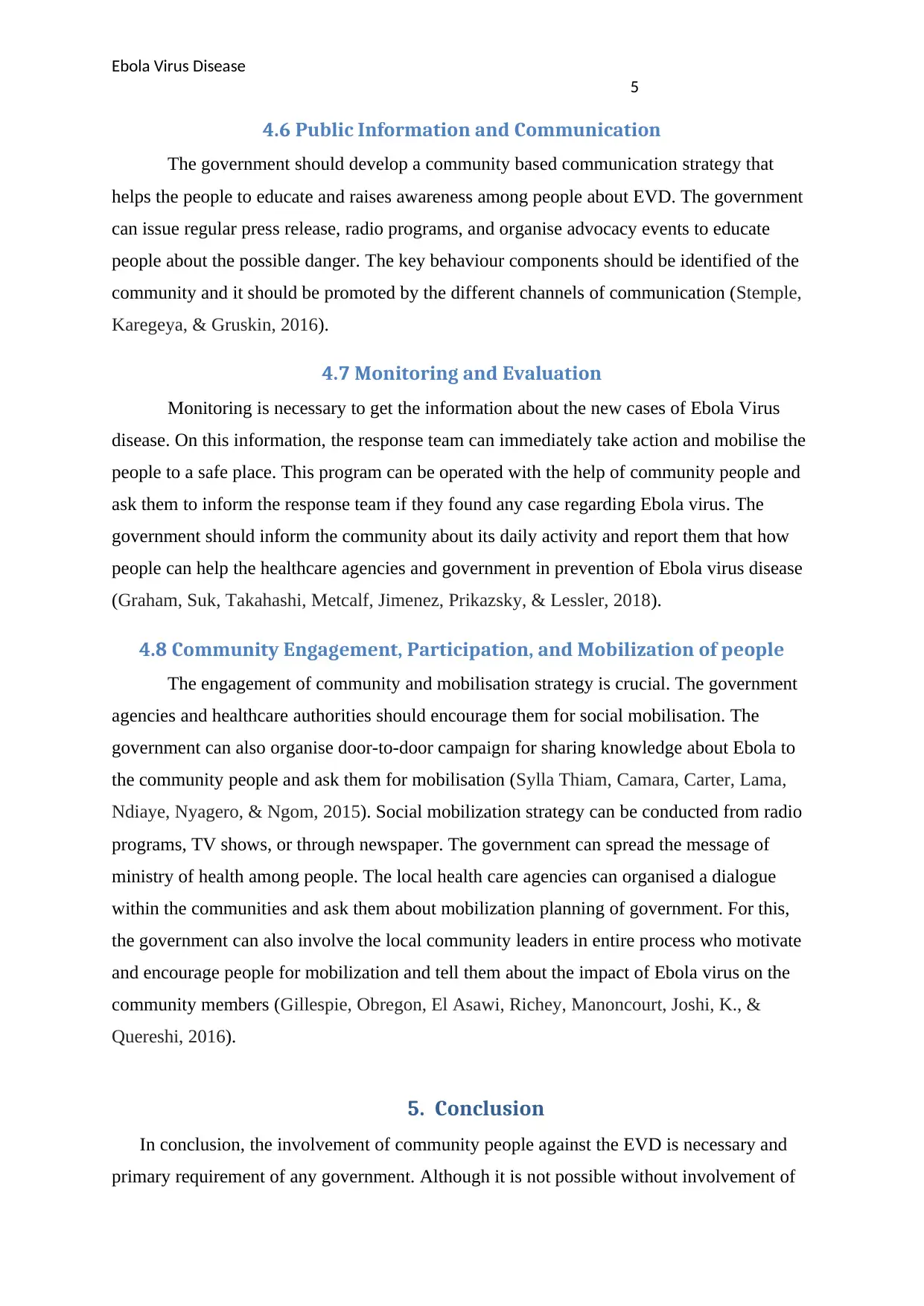
Ebola Virus Disease
5
4.6 Public Information and Communication
The government should develop a community based communication strategy that
helps the people to educate and raises awareness among people about EVD. The government
can issue regular press release, radio programs, and organise advocacy events to educate
people about the possible danger. The key behaviour components should be identified of the
community and it should be promoted by the different channels of communication (Stemple,
Karegeya, & Gruskin, 2016).
4.7 Monitoring and Evaluation
Monitoring is necessary to get the information about the new cases of Ebola Virus
disease. On this information, the response team can immediately take action and mobilise the
people to a safe place. This program can be operated with the help of community people and
ask them to inform the response team if they found any case regarding Ebola virus. The
government should inform the community about its daily activity and report them that how
people can help the healthcare agencies and government in prevention of Ebola virus disease
(Graham, Suk, Takahashi, Metcalf, Jimenez, Prikazsky, & Lessler, 2018).
4.8 Community Engagement, Participation, and Mobilization of people
The engagement of community and mobilisation strategy is crucial. The government
agencies and healthcare authorities should encourage them for social mobilisation. The
government can also organise door-to-door campaign for sharing knowledge about Ebola to
the community people and ask them for mobilisation (Sylla Thiam, Camara, Carter, Lama,
Ndiaye, Nyagero, & Ngom, 2015). Social mobilization strategy can be conducted from radio
programs, TV shows, or through newspaper. The government can spread the message of
ministry of health among people. The local health care agencies can organised a dialogue
within the communities and ask them about mobilization planning of government. For this,
the government can also involve the local community leaders in entire process who motivate
and encourage people for mobilization and tell them about the impact of Ebola virus on the
community members (Gillespie, Obregon, El Asawi, Richey, Manoncourt, Joshi, K., &
Quereshi, 2016).
5. Conclusion
In conclusion, the involvement of community people against the EVD is necessary and
primary requirement of any government. Although it is not possible without involvement of
5
4.6 Public Information and Communication
The government should develop a community based communication strategy that
helps the people to educate and raises awareness among people about EVD. The government
can issue regular press release, radio programs, and organise advocacy events to educate
people about the possible danger. The key behaviour components should be identified of the
community and it should be promoted by the different channels of communication (Stemple,
Karegeya, & Gruskin, 2016).
4.7 Monitoring and Evaluation
Monitoring is necessary to get the information about the new cases of Ebola Virus
disease. On this information, the response team can immediately take action and mobilise the
people to a safe place. This program can be operated with the help of community people and
ask them to inform the response team if they found any case regarding Ebola virus. The
government should inform the community about its daily activity and report them that how
people can help the healthcare agencies and government in prevention of Ebola virus disease
(Graham, Suk, Takahashi, Metcalf, Jimenez, Prikazsky, & Lessler, 2018).
4.8 Community Engagement, Participation, and Mobilization of people
The engagement of community and mobilisation strategy is crucial. The government
agencies and healthcare authorities should encourage them for social mobilisation. The
government can also organise door-to-door campaign for sharing knowledge about Ebola to
the community people and ask them for mobilisation (Sylla Thiam, Camara, Carter, Lama,
Ndiaye, Nyagero, & Ngom, 2015). Social mobilization strategy can be conducted from radio
programs, TV shows, or through newspaper. The government can spread the message of
ministry of health among people. The local health care agencies can organised a dialogue
within the communities and ask them about mobilization planning of government. For this,
the government can also involve the local community leaders in entire process who motivate
and encourage people for mobilization and tell them about the impact of Ebola virus on the
community members (Gillespie, Obregon, El Asawi, Richey, Manoncourt, Joshi, K., &
Quereshi, 2016).
5. Conclusion
In conclusion, the involvement of community people against the EVD is necessary and
primary requirement of any government. Although it is not possible without involvement of
⊘ This is a preview!⊘
Do you want full access?
Subscribe today to unlock all pages.

Trusted by 1+ million students worldwide
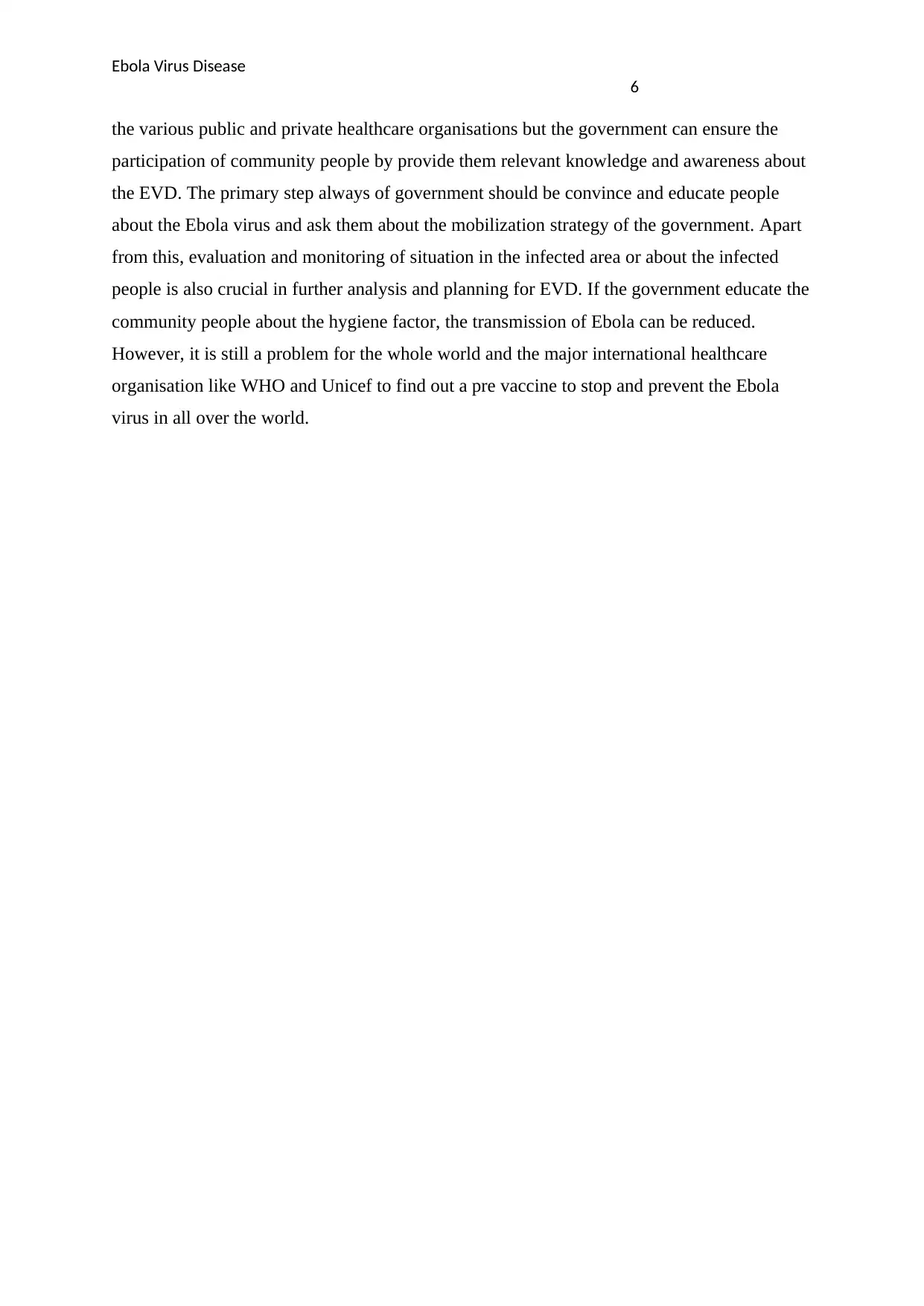
Ebola Virus Disease
6
the various public and private healthcare organisations but the government can ensure the
participation of community people by provide them relevant knowledge and awareness about
the EVD. The primary step always of government should be convince and educate people
about the Ebola virus and ask them about the mobilization strategy of the government. Apart
from this, evaluation and monitoring of situation in the infected area or about the infected
people is also crucial in further analysis and planning for EVD. If the government educate the
community people about the hygiene factor, the transmission of Ebola can be reduced.
However, it is still a problem for the whole world and the major international healthcare
organisation like WHO and Unicef to find out a pre vaccine to stop and prevent the Ebola
virus in all over the world.
6
the various public and private healthcare organisations but the government can ensure the
participation of community people by provide them relevant knowledge and awareness about
the EVD. The primary step always of government should be convince and educate people
about the Ebola virus and ask them about the mobilization strategy of the government. Apart
from this, evaluation and monitoring of situation in the infected area or about the infected
people is also crucial in further analysis and planning for EVD. If the government educate the
community people about the hygiene factor, the transmission of Ebola can be reduced.
However, it is still a problem for the whole world and the major international healthcare
organisation like WHO and Unicef to find out a pre vaccine to stop and prevent the Ebola
virus in all over the world.
Paraphrase This Document
Need a fresh take? Get an instant paraphrase of this document with our AI Paraphraser
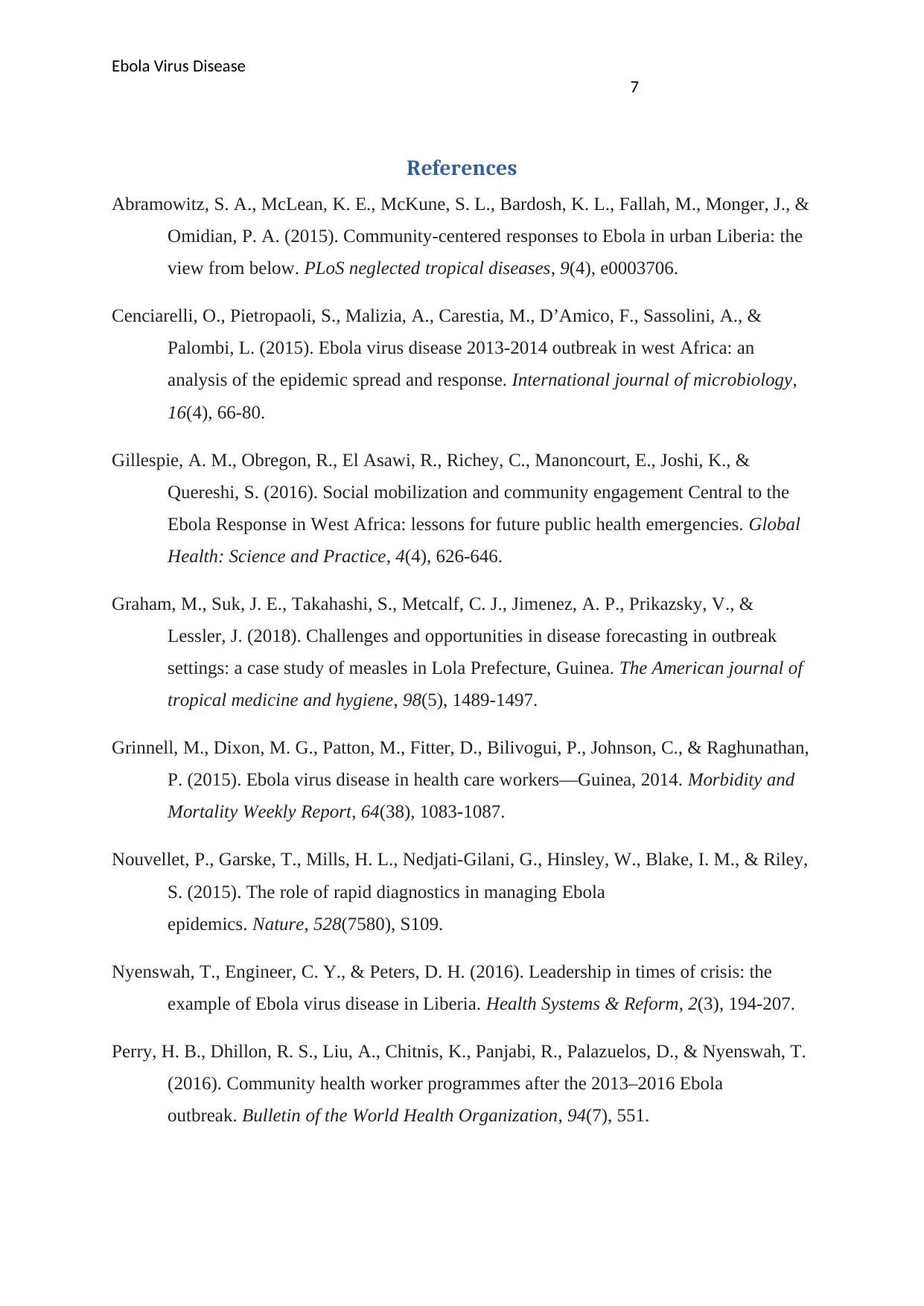
Ebola Virus Disease
7
References
Abramowitz, S. A., McLean, K. E., McKune, S. L., Bardosh, K. L., Fallah, M., Monger, J., &
Omidian, P. A. (2015). Community-centered responses to Ebola in urban Liberia: the
view from below. PLoS neglected tropical diseases, 9(4), e0003706.
Cenciarelli, O., Pietropaoli, S., Malizia, A., Carestia, M., D’Amico, F., Sassolini, A., &
Palombi, L. (2015). Ebola virus disease 2013-2014 outbreak in west Africa: an
analysis of the epidemic spread and response. International journal of microbiology,
16(4), 66-80.
Gillespie, A. M., Obregon, R., El Asawi, R., Richey, C., Manoncourt, E., Joshi, K., &
Quereshi, S. (2016). Social mobilization and community engagement Central to the
Ebola Response in West Africa: lessons for future public health emergencies. Global
Health: Science and Practice, 4(4), 626-646.
Graham, M., Suk, J. E., Takahashi, S., Metcalf, C. J., Jimenez, A. P., Prikazsky, V., &
Lessler, J. (2018). Challenges and opportunities in disease forecasting in outbreak
settings: a case study of measles in Lola Prefecture, Guinea. The American journal of
tropical medicine and hygiene, 98(5), 1489-1497.
Grinnell, M., Dixon, M. G., Patton, M., Fitter, D., Bilivogui, P., Johnson, C., & Raghunathan,
P. (2015). Ebola virus disease in health care workers—Guinea, 2014. Morbidity and
Mortality Weekly Report, 64(38), 1083-1087.
Nouvellet, P., Garske, T., Mills, H. L., Nedjati-Gilani, G., Hinsley, W., Blake, I. M., & Riley,
S. (2015). The role of rapid diagnostics in managing Ebola
epidemics. Nature, 528(7580), S109.
Nyenswah, T., Engineer, C. Y., & Peters, D. H. (2016). Leadership in times of crisis: the
example of Ebola virus disease in Liberia. Health Systems & Reform, 2(3), 194-207.
Perry, H. B., Dhillon, R. S., Liu, A., Chitnis, K., Panjabi, R., Palazuelos, D., & Nyenswah, T.
(2016). Community health worker programmes after the 2013–2016 Ebola
outbreak. Bulletin of the World Health Organization, 94(7), 551.
7
References
Abramowitz, S. A., McLean, K. E., McKune, S. L., Bardosh, K. L., Fallah, M., Monger, J., &
Omidian, P. A. (2015). Community-centered responses to Ebola in urban Liberia: the
view from below. PLoS neglected tropical diseases, 9(4), e0003706.
Cenciarelli, O., Pietropaoli, S., Malizia, A., Carestia, M., D’Amico, F., Sassolini, A., &
Palombi, L. (2015). Ebola virus disease 2013-2014 outbreak in west Africa: an
analysis of the epidemic spread and response. International journal of microbiology,
16(4), 66-80.
Gillespie, A. M., Obregon, R., El Asawi, R., Richey, C., Manoncourt, E., Joshi, K., &
Quereshi, S. (2016). Social mobilization and community engagement Central to the
Ebola Response in West Africa: lessons for future public health emergencies. Global
Health: Science and Practice, 4(4), 626-646.
Graham, M., Suk, J. E., Takahashi, S., Metcalf, C. J., Jimenez, A. P., Prikazsky, V., &
Lessler, J. (2018). Challenges and opportunities in disease forecasting in outbreak
settings: a case study of measles in Lola Prefecture, Guinea. The American journal of
tropical medicine and hygiene, 98(5), 1489-1497.
Grinnell, M., Dixon, M. G., Patton, M., Fitter, D., Bilivogui, P., Johnson, C., & Raghunathan,
P. (2015). Ebola virus disease in health care workers—Guinea, 2014. Morbidity and
Mortality Weekly Report, 64(38), 1083-1087.
Nouvellet, P., Garske, T., Mills, H. L., Nedjati-Gilani, G., Hinsley, W., Blake, I. M., & Riley,
S. (2015). The role of rapid diagnostics in managing Ebola
epidemics. Nature, 528(7580), S109.
Nyenswah, T., Engineer, C. Y., & Peters, D. H. (2016). Leadership in times of crisis: the
example of Ebola virus disease in Liberia. Health Systems & Reform, 2(3), 194-207.
Perry, H. B., Dhillon, R. S., Liu, A., Chitnis, K., Panjabi, R., Palazuelos, D., & Nyenswah, T.
(2016). Community health worker programmes after the 2013–2016 Ebola
outbreak. Bulletin of the World Health Organization, 94(7), 551.
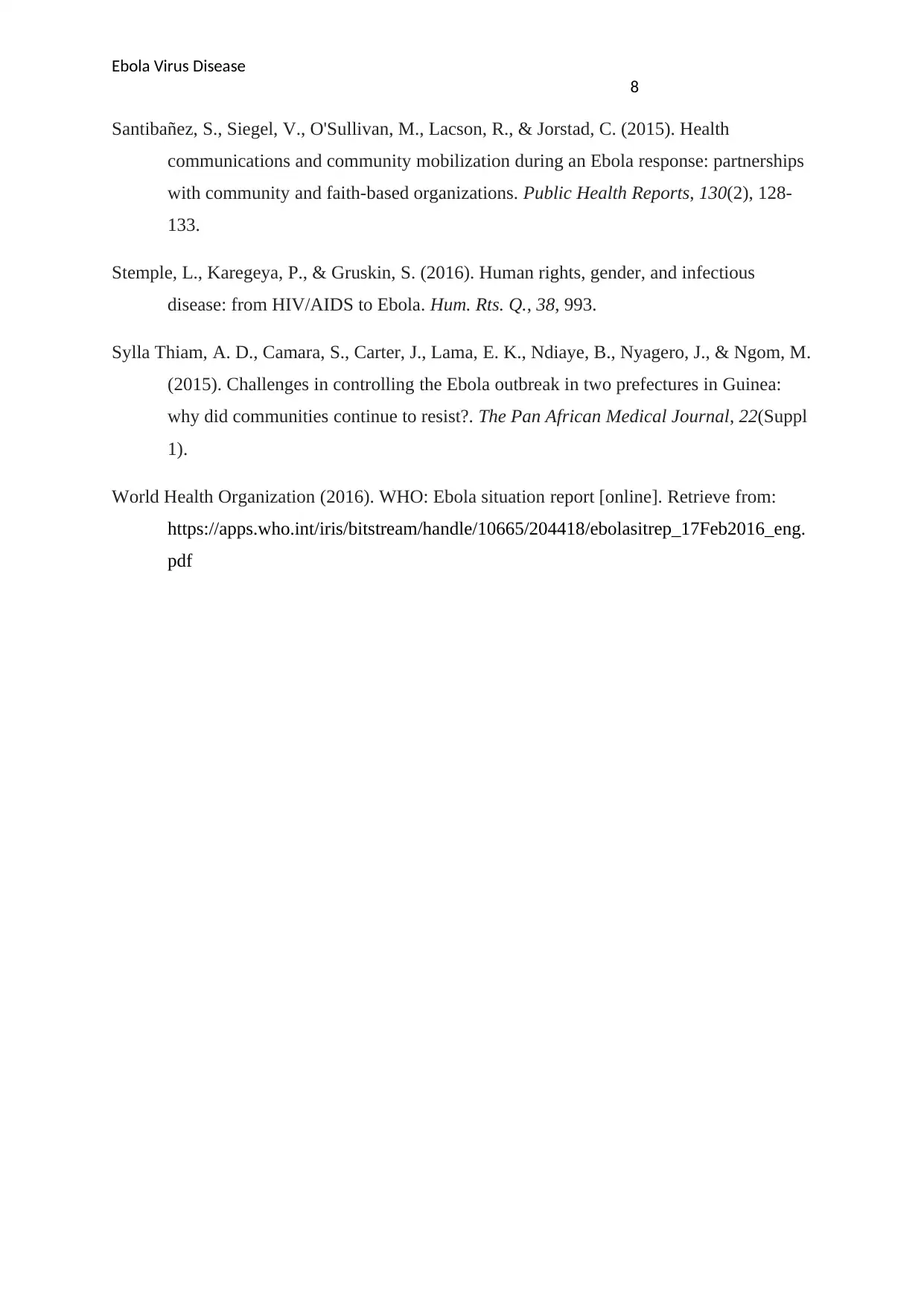
Ebola Virus Disease
8
Santibañez, S., Siegel, V., O'Sullivan, M., Lacson, R., & Jorstad, C. (2015). Health
communications and community mobilization during an Ebola response: partnerships
with community and faith-based organizations. Public Health Reports, 130(2), 128-
133.
Stemple, L., Karegeya, P., & Gruskin, S. (2016). Human rights, gender, and infectious
disease: from HIV/AIDS to Ebola. Hum. Rts. Q., 38, 993.
Sylla Thiam, A. D., Camara, S., Carter, J., Lama, E. K., Ndiaye, B., Nyagero, J., & Ngom, M.
(2015). Challenges in controlling the Ebola outbreak in two prefectures in Guinea:
why did communities continue to resist?. The Pan African Medical Journal, 22(Suppl
1).
World Health Organization (2016). WHO: Ebola situation report [online]. Retrieve from:
https://apps.who.int/iris/bitstream/handle/10665/204418/ebolasitrep_17Feb2016_eng.
pdf
8
Santibañez, S., Siegel, V., O'Sullivan, M., Lacson, R., & Jorstad, C. (2015). Health
communications and community mobilization during an Ebola response: partnerships
with community and faith-based organizations. Public Health Reports, 130(2), 128-
133.
Stemple, L., Karegeya, P., & Gruskin, S. (2016). Human rights, gender, and infectious
disease: from HIV/AIDS to Ebola. Hum. Rts. Q., 38, 993.
Sylla Thiam, A. D., Camara, S., Carter, J., Lama, E. K., Ndiaye, B., Nyagero, J., & Ngom, M.
(2015). Challenges in controlling the Ebola outbreak in two prefectures in Guinea:
why did communities continue to resist?. The Pan African Medical Journal, 22(Suppl
1).
World Health Organization (2016). WHO: Ebola situation report [online]. Retrieve from:
https://apps.who.int/iris/bitstream/handle/10665/204418/ebolasitrep_17Feb2016_eng.
⊘ This is a preview!⊘
Do you want full access?
Subscribe today to unlock all pages.

Trusted by 1+ million students worldwide
1 out of 9
Related Documents
Your All-in-One AI-Powered Toolkit for Academic Success.
+13062052269
info@desklib.com
Available 24*7 on WhatsApp / Email
![[object Object]](/_next/static/media/star-bottom.7253800d.svg)
Unlock your academic potential
Copyright © 2020–2025 A2Z Services. All Rights Reserved. Developed and managed by ZUCOL.




